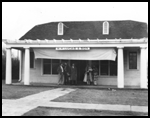Lost Buildings |
||
| Through the years buildings on the northeast side of the campus
became important centers of college life. Grand Avenue, the college’s eastern
boundary, was the location of many memorable addresses. |
||
|
It lasted quite a while. Located at the corner of Richards and Grand Avenue stands a small house designed in the 1920s by "Pep" Clyce, son of Austin College president Thomas S. Clyce. Originally, the cottage had a large windmill above its front entrance and was known as "The Dutch Treat Tearoom and Bookstore," operated by Dr. Clyce’s daughter, Dorothy. "The Dutch Treat" catered especially to students and faculty. In its present incarnation known as the Carruth Guest House, it serves as a residence for visiting professors. |
||
 September, 1895. --"The A.T.O.’s have a nice
building now almost completed and ready for occupancy. It is one of those built during
vacation. It has four lovely rooms below and a hall above, where they are soon to meet
regularly. Prof. Chandler is to occupy rooms in the building, and the goat being over the
professor’s head, many of the boys express a fear that it will greatly annoy
him." --The Reveille September, 1895. --"The A.T.O.’s have a nice
building now almost completed and ready for occupancy. It is one of those built during
vacation. It has four lovely rooms below and a hall above, where they are soon to meet
regularly. Prof. Chandler is to occupy rooms in the building, and the goat being over the
professor’s head, many of the boys express a fear that it will greatly annoy
him." --The ReveilleBuilt in 1895, the frame house at the corner of Grand and Richards Streets, known as 1023 N. Grand, was remodeled and enlarged in 1900 by Dr. Clyce and his wife, May, who occupied it for four decades. The Clyces entertained many dignitaries in their large house, including former U. S. President William Howard Taft. After the death of Dr. Clyce in 1946, Mrs. Clyce remained in the house for a number of years. It was eventually torn down, however, to make way for Settles House, the brick home which currently occupies that location. |
||
| The Lucas store, 1001 N. Grand, was located on the northeast corner of Grand Avenue and Williams Street, on the lot where Detweiler House now sits. For many years it provided necessities and snacks to Austin College students and residents of College Park. | ||
|
|
||
Bennett House was located on the southeast corner of Grand Avenue and Williams Street. |
||
|
|
||
| The latest street address, 923 N. Grand, was the site of the home of Professor Robert Ritchie Harwell, Professor of Greek, and his wife, Ellen, college librarian, a founder of the Campus Club, and a staunch supporter of women students after co-education in the 1920s. | ||
|
|
||
|
On Sundays it was a long, dirty trek downtown to church, and students could not escape it as they were required to attend church services. College Park Presbyterian Church was organized on November 8, 1900, with Dr. Clyce as its first pastor. The white frame sanctuary was finished in 1901. The building cost $8000, the furnishings more than $2000. In 1914 the name was changed to Grand Avenue Presbyterian Church although the white frame buildings continued to serve students and the East Sherman neighborhood for many years before being replaced by the present brick structure |
||
 "The College Park Church
stood just across from the campus. Sunday School and Church attendance was required of all
students, either at this church or some other specified. Monitors kept a record of
attendance." --Walter E. Long, Class of 1910. "The College Park Church
stood just across from the campus. Sunday School and Church attendance was required of all
students, either at this church or some other specified. Monitors kept a record of
attendance." --Walter E. Long, Class of 1910. |
||
|
|
||
 |
||

